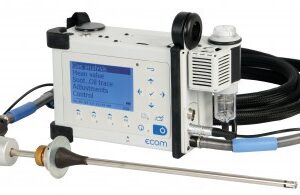The ecom-ST is a compact stationary analyzer for autonomous and continuous monitoring of gas emissions.
The analyzer can serve as rack insert, easily integrated in an existing cabinet or fitted with an optional protective housing for wall installation. The ecom-ST comes fitted with USB, Modbus TCP and RTU interfaces and an optional analog output.
The analyzer performs from 22 up to 144 measurements per day. The ecom-ST fits a standard 19” rack and can be equipped with up to 6 gas sensors, including O2,CO,NO,NO2,SO2, CH4 (IR), CO2 (IR), H2, H2S and Combustible.
It features an EPA recognized sample conditioning system containing a Peltier gas cooler/moisture removal system. Additional features are gas and ambient temperature measurement, stack pressure/draft measurement, large LCD screen with zoom capability, auto-draining, particulate filters, a flow meter, automatic CO over-range protection, sensor temperature monitoring and internal temperature compensation over the full operational range (20° to 105° F). The analyzer calculates CO2, efficiency, and excess air.
- Brand
- STANDARD FEATURES
- FUNCTION
- TECHNICAL SPECIFICATIONS
Brand
ECOM
STANDARD FEATURES
- Modular construction
- Programmable measuring cycles
- Gas sampling / fresh air purge monitoring via integrated magnetic valve
- Standard configuration includes Long-life O2 and CO sensors
- CO sensor over-range protection and fresh air purge to avoid measurement interruption
- Peltier cooler and electronically monitored condensate trap with automatic moisture removal
- Back-lit keypad and display
- High-performing gas pump for quick gas sampling
- Communication via Modbus RTU (RS485) or Modbus TCP (Ethernet)
- Optional aluminum chassis (fits 19 inch rack)
FUNCTION
Each electrochemical sensor has a circuit housed within an electrolyte solution and when the target gas is introduced into the sensor, the half reactions (oxidation and reduction) at the electrodes generate a flow of current through the circuit.
The voltage drop across the electrodes is measured by the analyzer and corresponds directly to the target gas concentration (i.e., the higher the concentration of gas, the more reactions that take place, the higher the current).
In each of the electrochemical sensors we use, there is also a third reference electrode which maintains a baseline potential for increased accuracy.









